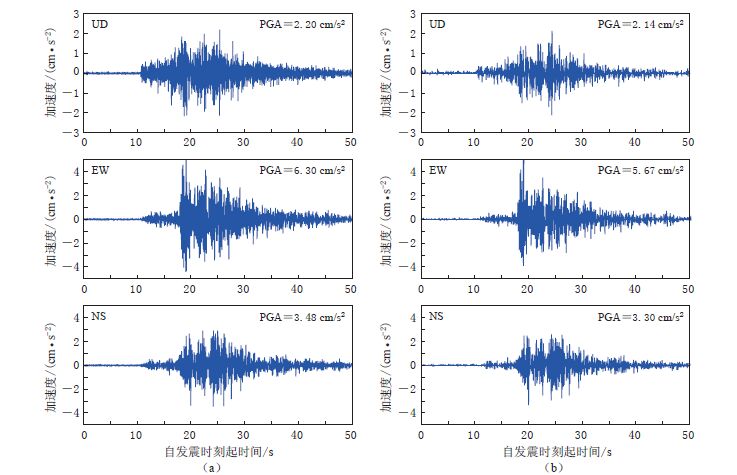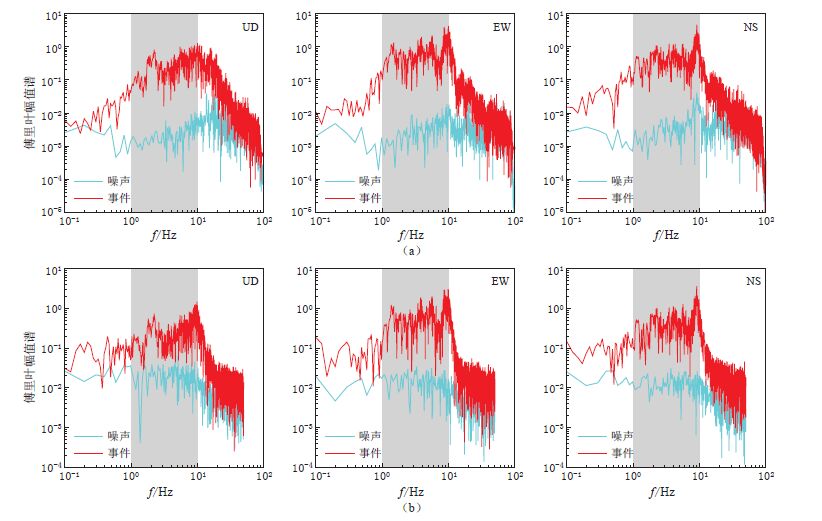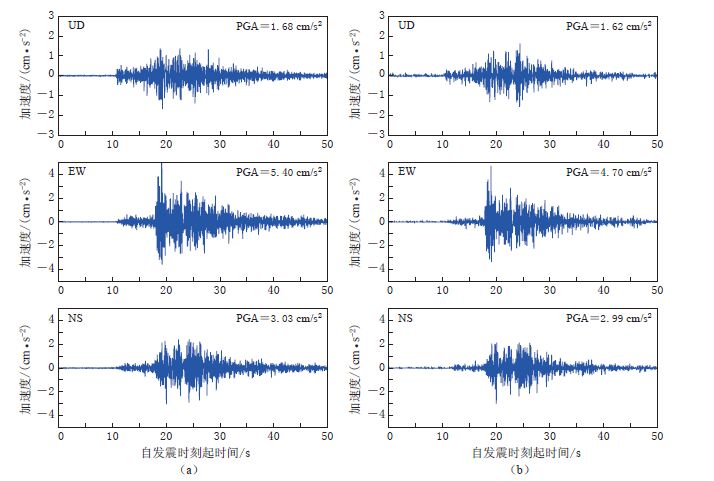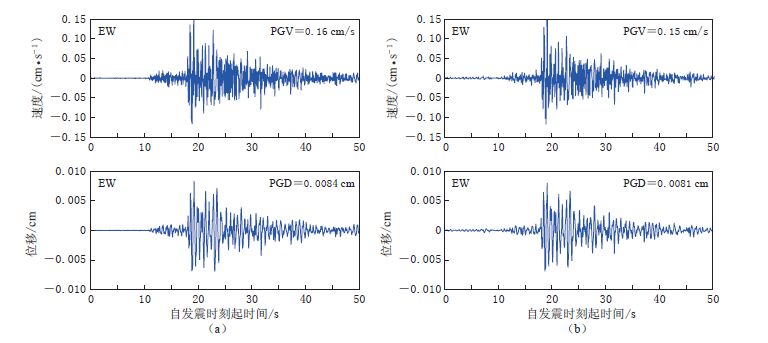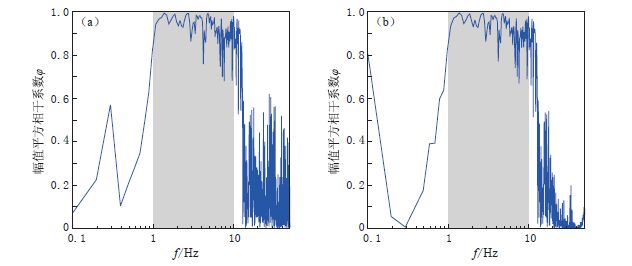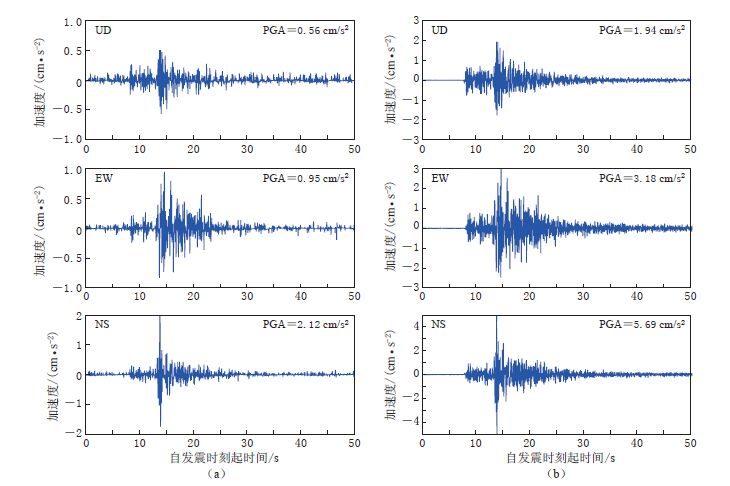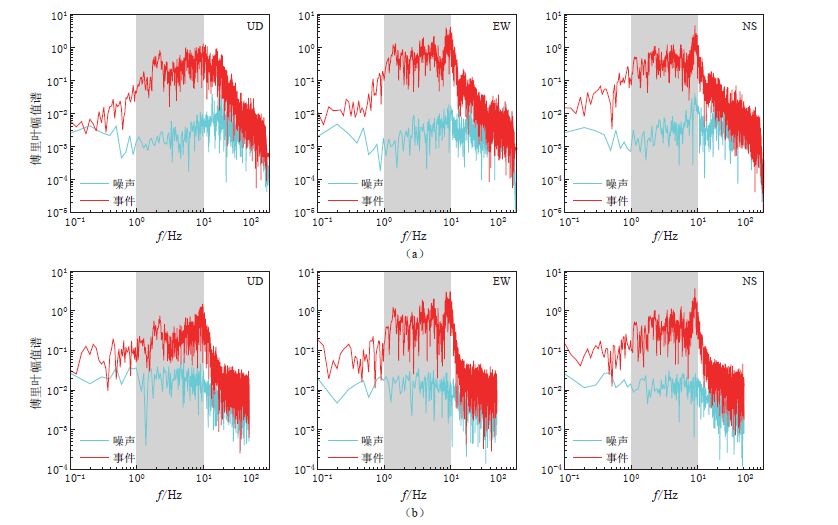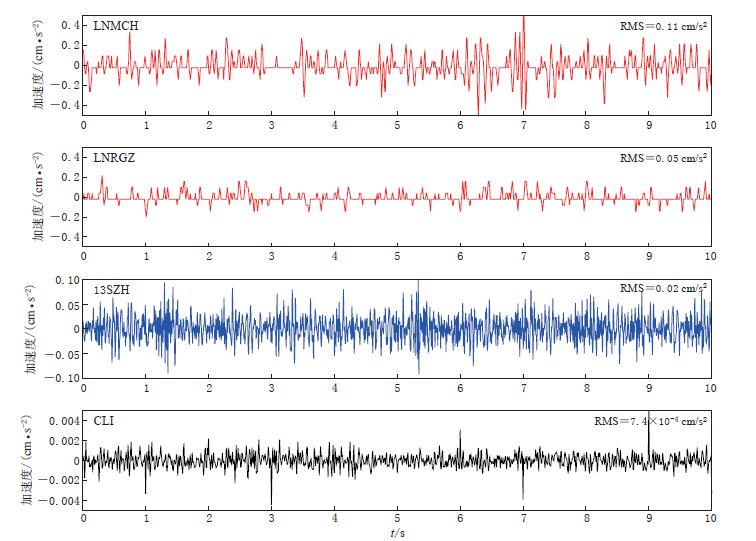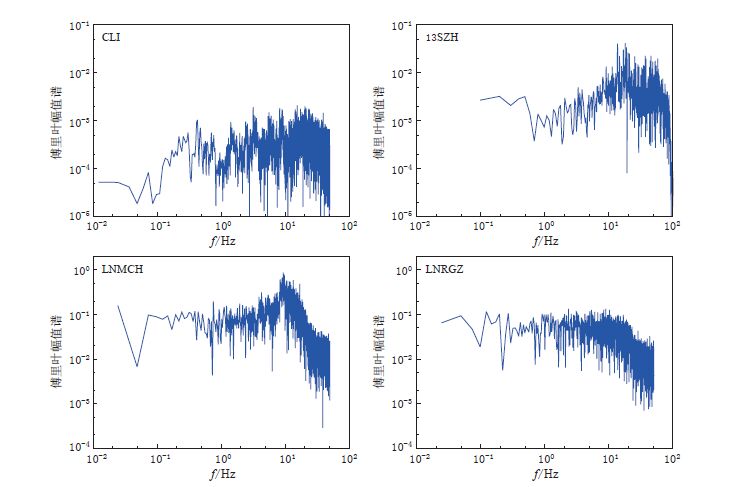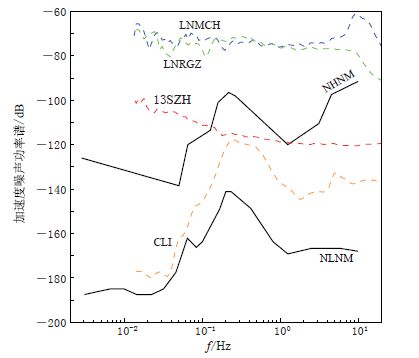Comparative analyses of records by seismic intensity instrument with strong ground motion records and seismograph stations records: Taking the ML4.5 Changli earthquake of Hebei Province for an example
-
摘要: 以2015年河北昌黎ML4.5地震中测震、强震及烈度仪台站记录到的事件波形为研究对象,通过对比分析挑选的两组观测台站的记录波形以及不同台站的噪声记录特征,获得了烈度仪台站观测记录能力及特点的认识.结果表明:烈度仪台站产出的记录在部分频段 (1—10 Hz) 与传统强震台站、测震台站均有较好的一致性,但在中长周期部分存在较大差异;在相同观测频带 (0.1—10 Hz) 下,由烈度仪台站记录积分得到的速度时程、位移时程也与强震台站、测震台站的观测结果具有良好的相关性,说明烈度仪台站产出的加速度记录具有一定的可积分性;烈度仪台站记录的噪声水平远超出强震台站和测震台站,基本为仪器自噪声,不包含天然地脉动成分.此外,由于本研究所用的烈度仪采用了16位的A/D转换器,对震相到时的精确拾取产生了不利影响.综上,本文认为烈度仪台站较适用于中强地震的近场观测.Abstract: Based on seismic records of Changli ML4.5 earthquake in Hebei Province, by analyzing two groups of waveforms and comparing seismic noise characteristics of seismograph station, strong ground motion station and seismic intensity instrument (SII) station, this paper acquires basic understanding of each kind of these stations, especially the SII station, such as the ability to record micro-earthquakes. The results show that, in certain frequency band (1--10 Hz), seismic waveforms are quite similar for both the SII station and the strong ground motion station or the seismograph station, but large differences appear in mid-long period part. For the same frequency band (0.1--10 Hz band-pass filtered), velocity history and displacement history that are integrated by the SII station data have good correlations and coherences with those from seismograph stations and strong ground motion stations, suggesting that the SII records have certain integrability to some extent. The noise levels of SII stations are far beyond seismograph stations and strong ground motion stations, normally are instrument noise without micro-tremor at all. As a result of only a 16 bit A/D convertor applied, the precision of sampled data is limited and then the accuracy of seismic phase picking will be adversely affected. In conclusion, we think that SII stations are more suitable for moderate to large near-field earthquakes monitoring.
-
Keywords:
- seismic intensity instrument /
- high frequency /
- seismic noise /
- A/D convertor
-
中国地震局工程力学研究所国家强震动台网中心提供强震数据支持,河北省地震局提供测震、烈度仪台网数据,两位审稿专家为完善本文提出了重要的修改建议,作者在此一并表示感谢.
-
-
金星, 张红才, 李军, 韦永祥, 马强. 2012.地震预警震级确定方法研究[J].地震学报, 34(5): 593-610. http://www.dzxb.org/stat/ShowHtml?ContentID=28783 Jin X, Zhang H C, Li J, Wei Y X, Ma Q. 2012. Research on earthquake early warning magnitude estimate[J]. Acta Seismologica Sinica, 34(5): 593-610 (in Chinese). http://en.cnki.com.cn/Article_en/CJFDTOTAL-DZXB201205002.htm
李昌珑. 2013.基于MEMS加速度传感器的地震烈度监测技术研究与实现[D].武汉:中国地震局地震研究所: 18-39. Li C L. 2013. Research and Achievement on Earthquake Intensity Monitoring Technology Based on MEMS Accelerometer[D]. Wuhan: Institute of Seismology, China Earthquake Administration: 18-39 (in Chinese).
廖诗荣, 陈绯雯. 2008.应用概率密度函数方法自动处理地震台站勘选测试数据[J].华南地震, 28(4): 82-92. http://www.cnki.com.cn/Article/CJFDTOTAL-HNDI200804009.htm Liao S R, Chen F W. 2008. Automated seismic noise processing for seismic site selection using probability density functions method[J]. South China Journal of Seismology, 28(4): 82-92 (in Chinese). http://cn.bing.com/academic/profile?id=6d87d4b6d824b460c46fe0a64aacc316&encoded=0&v=paper_preview&mkt=zh-cn
刘钢锋, 朱威, 邹彤, 林强. 2011. MEMS加速度传感器在强震观测中的应用[J].大地测量与地球动力学, 31(增刊): 168-170. http://www.cnki.com.cn/Article/CJFDTOTAL-DKXB2011S1040.htm Liu G F, Zhu W, Zou T, Lin Q. 2011. Application of MEMS acceleration sensor to macroseism observation[J]. Journal of Geodesy and Geodynamics, 31(Suppl): 168-170 (in Chinese).
王浩, 丁炜. 2011. MEMS加速度计与传统地震加速度计的比较研究[J].大地测量与地球动力学, 31(增刊Ⅱ): 93-95. http://www.cnki.com.cn/Article/CJFDTOTAL-DKXB2013S2028.htm Wang H, Ding W. 2011. Comparison among MEMS accelerometer and traditional seismometer[J]. Journal of Geodesy and Geodynamics, 31(Suppl Ⅱ): 93-95 (in Chinese).
许建华. 2006.基于微型传感器的地震加速度监测系统技术研究[D].北京:中国地震局地球物理研究所: 17-37. http://cn.bing.com/academic/profile?id=f3970aff8aeb0434831e200f5b68b434&encoded=0&v=paper_preview&mkt=zh-cn Xu J H. 2006. The Engineering System for Detection Earthquake Acceleration Based on Micromachined Accelerometer[D]. Beijing: Institute of Geophysics, China Earthquake Administration: 17-37 (in Chinese).
中国地震局. 2015.仪器地震烈度计算 (征求意见稿)[S/OL]. [2016-05-16]. http://www.cea.gov.cn/publish/dizhenj/465/539/20161115104509713440448/index.html. China Earthquake Administration. 2015. Calculation of Instrumental Seismic Intensity (Draft for Soliciting Opinions)[S/OL]. [2016-05-16]. http://www.cea.gov.cn/publish/dizhenj/465/539/20161115104509713440448/index.html (in Chinese).
Chen D Y, Hsiao N C, Wu Y M. 2015a. The Earthworm based Earthquake Alarm Reporting system in Taiwan[J]. Bull Seismol Soc Am, 105(2A): 568-579. doi: 10.1785/0120140147
Chen D Y, Wu Y M, Chin T L. 2015b. Incorporating low-cost seismometers into the Central Weather Bureau seismic network for earthquake early warning in Taiwan[J]. Terr Atmos Ocean Sci, 26(5): 503-513. doi: 10.3319/TAO.2015.04.17.01(T)
Evans J R, Allen R M, Chung A I, Cochran E S, Guy R, Hellweg M, Lawrence J F. 2014. Performance of several low-cost accelerometers[J]. Seismol Res Lett, 85(1): 147-158. doi: 10.1785/0220130091
Geller R J, Takeuchi N. 1995. A new method for computing highly accurate DSM synthetic seismograms[J]. Geophys J Int, 123(2): 449-470. doi: 10.1111/gji.1995.123.issue-2
Holland A. 2003. Earthquake data recorded by the MEMS accelerometer: Field testing in Idaho[J]. Seismol Res Lett, 74(1): 20-26. doi: 10.1785/gssrl.74.1.20
Horiuchi S, Horiuchi Y, Yamamoto S, Nakamura H, Wu C J, Rydelek P A, Kachi M. 2009. Home seismometer for earthquake early warning[J]. Geophys Res Lett, 36(5): L00B04. doi: 10.1029/2008GL036572.
Hsieh C Y, Chao W A, Wu Y M. 2015. An examination of the threshold-based earthquake early warning approach using a low-cost seismic network[J]. Seismol Res Lett, 86(6): 1664-1667. doi: 10.1785/0220150073
Jin X, Zhang H C, Li J, Wei Y X, Ma Q. 2013. Earthquake magnitude estimation using the τc and Pd method for earthquake early warning systems[J]. Earthquake Science, 26(1): 23-31. doi: 10.1007/s11589-013-0005-4
Lin T L, Wu Y M, Chen D Y, Hsiao N C, Chang C H. 2011. Magnitude estimations in earthquake early warning for the 2010 Jiasian, Taiwan, earthquake[J]. Seismol Res Lett, 82(2): 201-206. doi: 10.1785/gssrl.82.2.201
McNamara D E, Buland R P. 2004. Ambient noise levels in the continental United States[J]. Bull Seismol Soc Am, 94(4): 1517-1527. doi: 10.1785/012003001
Peterson J. 1993. Observations and Modeling of Seismic Background Noise[R]. USGS Open File Report 93-322. Albuquerque, New Mexico: U.S. Department of Interior Geological Survey: 322.
Tasi C Y, Lin T L, Wu Y M. 2015. Application of waveform stacking to low-cost local earthquake early warning arrays in Taiwan[J]. Seismol Res Lett, 86(6): 1668-1673. doi: 10.1785/0220150046
Wu Y M, Zhao L. 2006. Magnitude estimation using the first three seconds P-wave amplitude in earthquake early warning[J]. Geophys Res Lett, 33(16): L16312. doi: 10.1029/2006GL026871
Wu Y M, Yen H Y, Zhao L, Huang B S, Liang W T. 2006. Magnitude determination using initial P waves: A single-station approach[J]. Geophys Res Lett, 33(5): L05306.
Wu Y M, Chen D Y, Lin T L, Hsieh C Y, Chin T L, Chang W Y, Li W S, Ker S H. 2013. A high-density seismic network for earthquake early warning in Taiwan based on low cost sensors[J]. Seismol Res Lett, 84(6): 1048-1054. doi: 10.1785/0220130085
Wu Y M. 2014. Progress on development of an earthquake early warning system using low-cost sensors[J]. Pure Appl Geophys, 172(9): 2343-2351. doi: 10.1007/s00024-014-0933-5.
Zhang H C, Jin X, Wei Y X, Li J, Kang L C, Wang S C, Huang L Z, Yu P Q. 2016. An earthquake early warning system in Fujian, China[J]. Bull Seismol Soc Am, 106(2): 755-765. doi: 10.1785/0120150143
-
期刊类型引用(2)
1. 王晓青,丁香,丁玲,袁小祥. 影响地震生命损失的若干因素探讨——以2023年积石山6.2级地震为例. 中国应急救援. 2024(03): 10-16 .  百度学术
百度学术
2. 况春利,韩光洁,刘奕君,戴丹青. 甘肃积石山M_S6.2地震的多普勒效应. 大地测量与地球动力学. 2024(12): 1271-1274 .  百度学术
百度学术
其他类型引用(2)




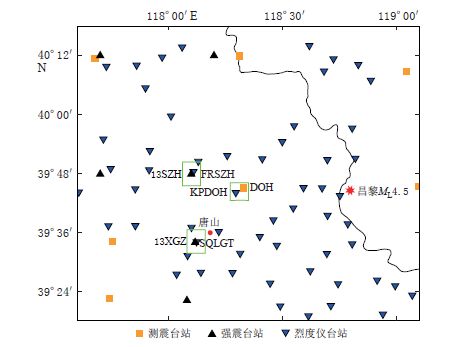
 下载:
下载:
